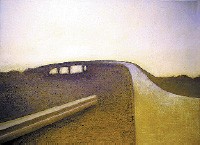There are no people, no cars, no buildings in Susan Maakestad’s spare visions of modernity. Swerving interstates, eerie colors, and complex textures make for compelling abstractions that look like the opening scenes of a film noir and recall the cityscapes of Richard Diebenkorn and Wayne Thiebaud.
Sunset and unshielded streetlights turn Culvert #3 smoky-red. A glowing pink ribbon of sky tops the concrete rubble of the sharply inclined Ramp #1, and in Street, Maakestad’s dry brush lets the fibers of cotton canvas show through to suggest gritty pavement narrowing to a point under a stormy, sooty sky.
Eighteen of Maakestad’s midsized canvases lining the right wall of Perry Nicole’s front and back galleries create an impression of unbroken movement. We speed past a blur of ochre fields and distant tree lines in Concrete & Trees #2, swerve around waterfronts in River and River #2, and in Speed Bump #2 we glide on a surfboard-shaped section of highway above a pitch-black sky.
Many of the works are painted low-to-the-ground and angled up, suggesting the perspective of a motorist focusing on the road ahead in a long drive that invites meditation. At the apex of Overpass, the highway disappears into an equally pale sky, reminding us of the impossibility of shoring ourselves against boundless energy and space no matter how sophisticated our concrete and steel infrastructures. Dusty pink expressways crossing smoky-red rivers (Barrier and Barrier #2) bring to mind the turmoil and emotional intensity in the cities Maakestad’s interstates connect.
When we end our journey at Parking Space #3 (a scumbled lot bordered by barren gray sky and an equally barren patch of yellow-green grass), there are still no people, no cars, no homes, no trees. Maakestad’s stark interstates have taken us for a mesmerizing ride that seems to ask: Beyond the concrete and beyond the frenetic pace of modern life, when/if we finally slow down, what will remain of our sense of community and self?

Susan Maakestad’s Overpass
Elizabeth Alley also takes us for a ride with eight small oils on canvas depicting commercial signs, the flat roofs of small businesses, the tops of treelines, and an occasional telephone pole.
The signs’ simple geometric shapes, vivid colors, and crisp lettering allow us to process their information and read their words quickly. Their oblique angles suggest the world we see when we crane our necks in fast-moving cars scanning strip malls for grocery stores (Ramona’s Tomato), candy shops (Flower’s Kiss #2), and fast-food restaurants (Pocky). Oriental lettering and the word “Pocky” printed on a maroon sign back-dropped by a clear blue sky bring to mind a combination gas station/fast-food restaurant that serves up sushi and Southern-fried chicken.
Nine of Alley’s figurative works hang in Perry Nicole’s front gallery, including the tiny, provocative Fishnets. In this 8-by-8-inch dramatically cropped portrait, a woman’s legs are bare except for a pair of wide-mesh stockings. Another figure’s high-heeled foot straddles the first woman’s thigh in a close-up that raises more questions than the scene’s modicum of information will ever answer.
Paintings derived from vintage family photos prove Alley a magician of memory. In the particularly resonant, conceptually rich Family Car, crisp shadows and confident strokes of impastoed paint make a scene from the early ’60s come alive. Bright gallery lights shining on the thick oils convincingly replicate the gloss of patent leather shoes, bronzed skin, the glare of sunlight on metal bumpers, and the brilliance of new car chrome.
An unusually lean and long 2-by-5-foot canvas accentuates the shape of a family sedan circa 1960s and crops the heads of two leggy teenagers, allowing viewers age 40 and over to become these youngsters and to reclaim the memory of a summer road trip complete with new shoes, new roadster, and Coppertone tans.
A shadow in the painting’s foreground suggests the silhouette of the mother/photographer who memorialized this scene for family archives. A photographer takes a picture that becomes the snapshot that becomes the work of art that depicts the photographer taking the snapshot that becomes … ad infinitum … a family portrait that goes beyond nostalgia to play with our notions regarding creativity, memory, time, and reality.
At Perry Nicole Fine Art through November 27th